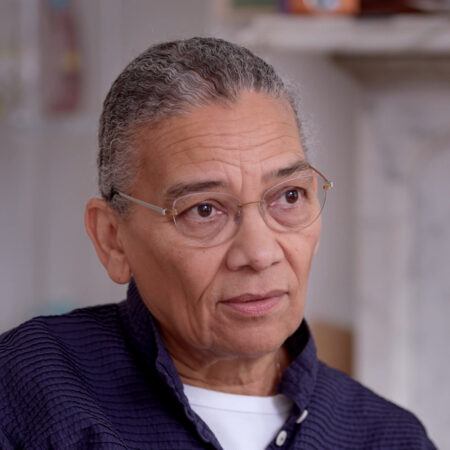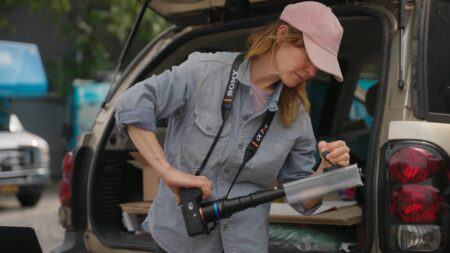Lubaina Himid

Lubaina Himid was born in 1954 in Zanzibar, Tanzania, and currently lives and works in Preston, United Kingdom. She received a BA at Wimbledon College of Art in 1976 and an MA from the Royal College of Art in 1984. Through her paintings, installations, and sculptures, Himid creates platforms for viewers to engage with pressing questions about race, gender, class, and history. Working on traditional canvases, cut-out cardboard portraits, or repurposed domestic furniture, the artist calls attention to forgotten marginalized histories and people and connects them to the present. An early pioneer of the Black Arts Movement, Himid has been an advocate for inclusion in the art world, curating exhibitions and creating spaces for Black female artists in the United Kingdom.
In works like Fish Seller: Safety or Danger (2023) or Talisman Seller (2023), the artist honors the lives and labors of these historical vendors through her portraits, acknowledging the dignity of these subjects through her close attention to their clothing, wares, and facial expressions. In other portraits, Himid uses familiar objects such as desks, drawers, and wardrobes as painting surfaces, as in Woman in a Creaking Drawer (2023), Man in a Pyjama Drawer (2023), or Feeling Colour by Touch (2019). “When I am painting on objects, I am trying even more to say, we are all part of this conversation,” the artist says. “I have made this pattern or this portrait or this scene on something that I know you know.” In her installation Aunties (2024), Himid paints on wooden planks sourced from floorboards, furniture remnants, and crates in order to create characters that represent the women who offered her guidance and support throughout her life. Through her painting practice, Himid memorializes figures who are often absent from dominant historical narratives while exploring how race, gender, and class can determine who is remembered and who is forgotten.
Trained in theater design, Himid’s works often contain interactive and immersive dimensions, whether through her free-standing cut-out paintings, installation choices, or compositional strategies that invite viewers’ participation in the action of a painting. In her series Strategy Paintings (2022-2023), the artist paints fictional characters sitting and standing around tables, often leaving an empty chair in the painting for viewers to imagine themselves sitting in and taking part. In other works, such as Naming the Money (2004), the artist creates life-sized painted cut-out figures arranged in a tableau that viewers walk through and around. Naming the Money features portraits of 100 enslaved and displaced African artisans, with their stories written on the backs of the cut-out portraits and heard through a soundtrack playing in the gallery. “You see that there is a political gap, in which you can situate yourself, and sometimes an actual space in the canvas,” says Himid. “There’s room for you, the audience member, at that table. That’s telling you something.”
Videos 1
-
Trailer
“I’m trying to disrupt, to remind, to cause tension, and to cause you to not quite be able to look as you usually could look. I want to show a moment between the question and the answer. In between a question and an answer, the whole world takes place.”
Lubaina Himid

